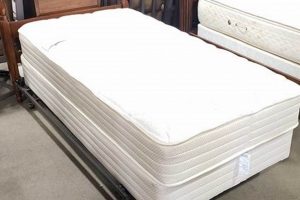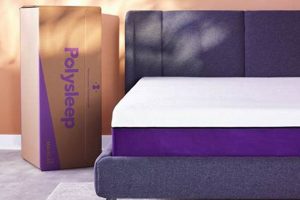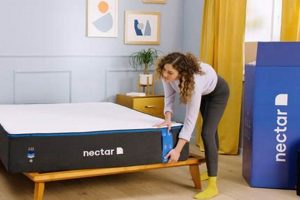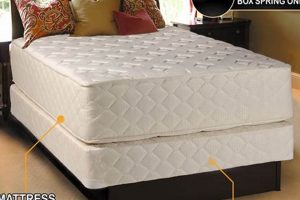These sleep surfaces offer direct support, engineered to function without a traditional foundation. Examples include memory foam, latex, and hybrid models designed for platform beds, adjustable bases, or the floor. This design contrasts sharply with conventional innerspring units often requiring a separate support structure.
The key advantage lies in streamlined setup and modern aesthetics. This can translate into cost savings, eliminating the need to purchase an additional foundation. Historically, box springs absorbed shock and provided height; however, advancements in mattress technology have rendered this function largely obsolete for many mattress types, contributing to the rise of designs that do not require them.
The subsequent sections will delve into the diverse range of available options, explore the specific support requirements of various mattress types, and outline the criteria for selecting the appropriate supporting structure, if any, to optimize comfort and longevity.
Guidance on Mattress Selection and Support
Considerations surrounding mattress selection often extend beyond the material composition of the sleep surface itself. Understanding support requirements and bed frame compatibility is crucial for ensuring optimal comfort and longevity.
Tip 1: Assess Mattress Type. Different mattress types possess varying support requirements. Memory foam and latex models generally function effectively on solid or slatted platforms. Innerspring units, particularly older designs, may benefit from a more substantial foundation to prevent sagging.
Tip 2: Evaluate Bed Frame Compatibility. The existing bed frame must provide adequate support. Platform beds with closely spaced slats or a solid surface are typically suitable. Frames with widely spaced slats may require additional support to prevent mattress deformation.
Tip 3: Consider Weight Distribution. The intended weight load should align with the mattress and frame specifications. Overloading a mattress or frame can accelerate wear and compromise structural integrity.
Tip 4: Inspect Slat Spacing. For slatted bed frames, the spacing between slats should not exceed two to three inches. Wider gaps can lead to uneven support and premature mattress sagging.
Tip 5: Review Manufacturer Guidelines. Consult the manufacturer’s recommendations regarding support requirements. Adhering to these guidelines ensures warranty validity and optimal performance.
Tip 6: Evaluate Floor Placement. Direct floor placement is a viable option for certain mattress types, particularly those constructed with breathable materials. However, consider potential issues related to moisture accumulation and airflow.
Tip 7: Monitor for Sagging. Regularly inspect the mattress surface for signs of sagging or uneven wear. Addressing these issues promptly can prevent further damage and maintain comfort.
Following these guidelines ensures correct product selection and proper support configuration, maximizing the lifespan and comfort of your sleep system.
The following sections will address common misconceptions and clarify lingering uncertainties surrounding mattress support and foundational requirements.
1. Direct Support
Direct support is a cornerstone characteristic, fundamentally defining its function and differentiating it from traditional mattress setups. This inherent support system eliminates the necessity for a separate foundation, providing a self-contained sleep solution.
- Integrated Construction
The mattress’s internal layers are engineered to provide complete support. High-density foams, individually wrapped coils, or advanced latex configurations distribute weight evenly across the sleep surface. Examples include multi-layered memory foam mattresses and hybrid models with reinforced edge support. This integrated design ensures consistent support, minimizing pressure points and promoting proper spinal alignment without external assistance.
- Weight Distribution Efficiency
Effective weight distribution is crucial for mitigating stress on individual components and maximizing mattress longevity. These mattresses are designed to disperse weight across a broader surface area, reducing concentrated pressure. For instance, a mattress with zoned support strategically places denser materials in areas requiring greater reinforcement, such as the lumbar region. This targeted approach enhances comfort and prolongs the lifespan of the mattress by preventing localized sagging or deformation.
- Platform Bed Compatibility
Direct support inherently implies compatibility with platform beds. These beds feature a solid or closely slatted surface, providing a stable base without a box spring. The mattress’s self-supporting structure ensures proper performance on such platforms. Conversely, using this type of mattress on a foundation designed for innerspring models may compromise support and accelerate wear due to incompatible support structures.
- Elimination of Motion Transfer
The design often minimizes motion transfer, a critical factor for shared sleep environments. Internal construction, such as individually wrapped coils, isolates movement, preventing disturbances from transferring across the mattress surface. For example, a sleeper shifting positions on one side of the bed will have minimal impact on the other side. This attribute contributes to a more restful and undisturbed sleep experience.
These facets illustrate the significance of direct support in the context of a mattress designed to function without a box spring. The self-contained support system enables compatibility with various bed frames, simplifies setup, and enhances overall sleep quality. Ultimately, the capacity to deliver comprehensive support independently underscores its value proposition as a modern and efficient sleep solution.
2. Platform Compatibility
Platform compatibility is a defining characteristic that distinguishes these mattress designs from traditional setups. This feature facilitates direct placement on platform bed frames, eliminating the need for a separate box spring or foundation.
- Solid Surface Support
Platform beds typically feature a solid surface or closely spaced slats, providing a stable and even base for the mattress. This solid support is crucial, as the mattress relies on it for proper weight distribution and structural integrity. Examples include wooden platforms and metal frames with closely spaced slats (typically no more than 2-3 inches apart). The mattress is engineered to function optimally on such surfaces, ensuring consistent support and preventing sagging.
- Enhanced Airflow Considerations
While solid surfaces offer robust support, airflow can be a concern. Some platform beds incorporate slatted designs to improve ventilation and prevent moisture accumulation. In these cases, the slat spacing must be carefully considered to ensure adequate support and prevent mattress deformation. For example, wide slat spacing may require additional support to prevent sagging in specific areas, especially for heavier individuals or those with uneven weight distribution.
- Low-Profile Aesthetics
Platform compatibility contributes to a low-profile aesthetic, often desired in contemporary bedroom designs. The absence of a box spring reduces the overall bed height, creating a streamlined and minimalist appearance. This can be particularly appealing in smaller spaces or for individuals who prefer a lower bed height for ease of access. In contrast, traditional innerspring mattresses paired with box springs typically result in a significantly higher bed profile.
- Frame Material Versatility
Platform beds are available in a wide range of materials, including wood, metal, and upholstered options. This versatility allows for seamless integration with various bedroom styles and dcor preferences. For instance, a wooden platform bed complements a rustic or natural aesthetic, while a metal frame lends itself to a more modern or industrial design. The mattress adapts to these various frame styles without compromising support or comfort.
The inherent compatibility with platform beds is a key selling point, offering a simplified and aesthetically pleasing alternative to traditional mattress setups. This feature not only streamlines the setup process but also provides a wider range of design options for creating a comfortable and visually appealing sleep environment.
3. Modern Aesthetics
The design evolution away from traditional box spring mattress configurations directly correlates with a shift toward minimalist and streamlined bedroom aesthetics. The visual impact of eliminating the bulky box spring allows for a lower bed profile, which aligns with contemporary design principles emphasizing clean lines and uncluttered spaces. This adaptation satisfies the aesthetic preferences of consumers seeking a modern, minimalist bedroom design.
Consider, for instance, platform beds, which are designed explicitly for use with such mattresses. These bed frames often feature sleek, geometric shapes and utilize materials like metal or wood with minimalist detailing. The absence of a box spring allows these design elements to take center stage, enhancing the room’s overall visual appeal. Examples include Scandinavian-inspired bedrooms with low-profile platform beds and mid-century modern bedrooms with minimalist wooden bed frames.
The integration of the mattress into modern aesthetics extends beyond visual appeal. A lower bed height can also create a sense of spaciousness, particularly beneficial in smaller bedrooms. This contributes to a feeling of openness and tranquility, further aligning with the principles of modern design. Therefore, modern aesthetic design plays a crucial role in mattress development and popularity, contributing significantly to the minimalist bedroom aesthetic.
4. Cost Efficiency
The absence of a box spring translates directly into financial savings, representing a significant aspect of overall affordability. This initial cost reduction extends beyond the immediate purchase price, influencing long-term expenses associated with bedroom furnishings.
- Elimination of Initial Expense
The most immediate cost benefit is the elimination of the expense associated with purchasing a separate box spring. Standard box springs can range from several hundred to over a thousand dollars, depending on size and quality. Eliminating this upfront cost makes such mattresses a more attractive option for budget-conscious consumers. Examples include first-time homebuyers furnishing a new home or individuals seeking to replace an existing mattress on a limited budget.
- Reduced Transportation Costs
Transporting a mattress and box spring requires more space and effort than transporting a mattress alone. Opting for a model eliminates the need for additional vehicle space or professional moving services, resulting in further cost savings. This is particularly relevant for individuals living in urban areas with limited parking or those who prefer to handle their own moving arrangements.
- Simplified Setup and Assembly
The setup process is inherently simpler and faster, translating into potential savings on professional assembly services. With no need to align and attach a box spring to a bed frame, individuals can often complete the setup independently. This is especially beneficial for those who prefer a DIY approach or want to avoid the added expense of hiring professional installers.
- Potential for Longer Lifespan
While not guaranteed, some mattresses may exhibit a longer lifespan due to their inherent design and construction, potentially offsetting replacement costs over time. By providing consistent and even support without relying on a separate foundation, the mattress may experience less wear and tear, potentially extending its usable life. This long-term cost benefit further enhances the overall affordability.
The cost efficiencies derived from opting for a model without a box spring extend beyond the initial purchase price. Reduced transportation costs, simplified setup, and the potential for a longer lifespan contribute to a financially advantageous solution for consumers seeking a cost-effective and convenient sleep system. This ultimately offers a streamlined and budget-friendly solution for furnishing a bedroom.
5. Design Innovation
Design innovation is central to the development and adoption of mattress designs that do not require a box spring. This evolution encompasses material science, structural engineering, and manufacturing processes, leading to products that offer improved support, comfort, and durability without a traditional foundation. The relevance of design innovation is evident in the proliferation of memory foam, latex, and hybrid models engineered for platform beds and adjustable bases.
- Advanced Material Utilization
The integration of advanced materials, such as high-density memory foam and responsive latex, plays a critical role. These materials offer superior pressure relief and contouring compared to traditional innerspring systems, negating the need for a box spring to absorb shock and distribute weight. For example, multi-layered memory foam mattresses incorporate varying densities to provide targeted support and enhanced comfort. The development of these materials directly contributes to the viability of mattress designs that function independently.
- Optimized Structural Engineering
Structural engineering innovations ensure adequate support and stability without a box spring. This includes reinforced edge support, zoned support systems, and advanced coil configurations. Reinforced edges prevent sagging and provide a consistent sleep surface, while zoned support targets specific areas of the body, such as the lumbar region. Individually pocketed coils minimize motion transfer and enhance contouring. These engineering advancements create a self-supporting structure that performs effectively on platform beds or adjustable bases.
- Enhanced Manufacturing Processes
Modern manufacturing processes enable the precise layering and assembly of different materials to optimize performance. Techniques such as compression packaging and direct-to-consumer delivery have streamlined the distribution process, reducing costs and improving accessibility. Furthermore, advancements in adhesive technologies and automated assembly lines ensure consistent quality and durability. These manufacturing innovations support the mass production and widespread availability of mattress designs that do not require a box spring.
- Integration with Adjustable Bases
Design innovation facilitates seamless integration with adjustable bed bases, which are becoming increasingly popular. The flexibility and conforming capabilities of memory foam and latex mattresses make them ideal for use with adjustable bases, providing customized support and comfort. In contrast, traditional innerspring mattresses often lack the necessary flexibility and may be damaged by adjustable bases. The compatibility with adjustable bases further reinforces the value proposition of mattress designs that do not require a box spring.
These facets of design innovation underscore the transformative impact on mattress technology. The integration of advanced materials, optimized structural engineering, enhanced manufacturing processes, and compatibility with adjustable bases have collectively enabled the development of mattress designs that offer superior performance and convenience without a traditional box spring. These advancements contribute to a more comfortable, supportive, and aesthetically pleasing sleep environment, reflecting a paradigm shift in the mattress industry.
Frequently Asked Questions
The following section addresses common inquiries regarding mattresses designed for use without a traditional box spring, clarifying their functionalities and addressing potential concerns.
Question 1: What defines a “no box spring mattress”?
A mattress specifically engineered to provide adequate support and comfort without the use of a separate box spring or foundation. Its internal construction is designed to distribute weight evenly and maintain structural integrity when placed directly on a platform bed, adjustable base, or the floor.
Question 2: Are these mattresses suitable for all bed frames?
While versatile, compatibility depends on the bed frame type. Platform beds with solid surfaces or closely spaced slats are ideal. Frames with widely spaced slats may require additional support to prevent sagging. Consultation of the manufacturer’s guidelines is advised.
Question 3: Does the absence of a box spring affect mattress lifespan?
Lifespan depends on factors such as mattress material, construction quality, and usage. When used with a suitable support structure, the absence of a box spring does not inherently shorten a mattress’s lifespan. Proper support is crucial, regardless of the foundation type.
Question 4: Is floor placement a viable option?
Direct floor placement is possible for certain mattress types, particularly those with breathable materials. However, concerns about moisture accumulation, airflow restriction, and potential mold growth warrant consideration. Regular lifting and ventilation are recommended.
Question 5: How does this mattress type impact motion transfer?
Many mattresses of this type, particularly memory foam and hybrid models, incorporate features to minimize motion transfer. Individually wrapped coils and dense foam layers can isolate movement, reducing disturbances for sleep partners. The effectiveness varies based on specific construction.
Question 6: Are these mattresses more affordable than traditional sets?
The elimination of the box spring expense often results in a lower overall cost, making these mattresses a potentially more affordable option. However, the price range varies significantly based on materials, construction quality, and brand reputation. A comprehensive price comparison is advisable.
Understanding these points facilitates informed decision-making when considering mattresses designed for use without a traditional box spring.
The following section will provide guidance on selecting appropriate supporting structures when a box spring is not utilized.
Conclusion
The preceding exploration of “no box spring mattress” highlights a paradigm shift in sleep system design. The reliance on internal support structures, advanced materials, and platform bed compatibility characterizes a departure from traditional mattress setups. These design choices represent a focused effort to balance cost-effectiveness, aesthetic appeal, and functionality.
Consideration of individual needs and preferences remains paramount. While the trend toward mattress designs that do not require box springs is evident, a thorough assessment of support requirements, bed frame compatibility, and potential long-term benefits is essential. The future may see further innovation in mattress technology, creating even more diverse and specialized sleep solutions.


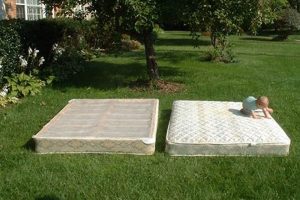
![Best King Size Box Spring Mattress [Guide] Organic & Natural Mattress Buyer’s Guide: Non-Toxic Sleep Solutions Best King Size Box Spring Mattress [Guide] | Organic & Natural Mattress Buyer’s Guide: Non-Toxic Sleep Solutions](https://mattressworldpa.com/wp-content/uploads/2025/07/th-3357-300x200.jpg)
